For a printable version of the newsletter, click here.
Hello there, Einkorn here.
Einkorn in July: turned brittle in the hot sun over the Columbia Plateau, no longer pliant when the wind blows but leaning with a rustle, a rasping undulation of plants turning to straw, leaves wilted, grain heads bent, prickly, prickly like bones whose flesh’s come off, emaciated, skeletal – but not moribund because as the plant bakes to its death the grain seed ripens fully to the promise of life many times multiplied.
That’s a lot of grain waiting to be harvested at Lentz Spelt Farms, a 12,000-bushel bin ready for what will come off the 120-acre dryland field. Which calculation takes into account that in-hull Farro grain is much bulkier than free-threshing wheats; Farro bushel weights come in at 25 to 38 pounds, compared to the about 60 pounds per bushel of wheat.
Einkorn in July: turned brittle in the hot sun over the Columbia Plateau, no longer pliant when the wind blows but leaning with a rustle, a rasping undulation of plants turning to straw, leaves wilted, grain heads bent, prickly, prickly like bones whose flesh’s come off, emaciated, skeletal – but not moribund because as the plant bakes to its death the grain seed ripens fully to the promise of life many times multiplied.
That’s a lot of grain waiting to be harvested at Lentz Spelt Farms, a 12,000-bushel bin ready for what will come off the 120-acre dryland field. Which calculation takes into account that in-hull Farro grain is much bulkier than free-threshing wheats; Farro bushel weights come in at 25 to 38 pounds, compared to the about 60 pounds per bushel of wheat.
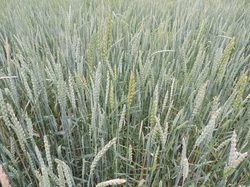
Even close to harvest most industrially bred crops still stand orderly. But tall Farro has danced itself into a criss-cross tousle, stabbing every which way like an old Norse berserkr: not all the wild has been domesticated out of Triticum monoccocum, T. diccocum, T. spelta.
The baker viewing the field at this point is hoping for good gluten, thinking bread. Especially with Spelt – of the Farro grains the most commonly used for breads both hard-crust and sandwich – the gluten content in the grain matters.
Gluten is protein but not all proteins are gluten. Some land race types contain better gluten than others. Some years the environmental conditions are better for gluten than other years. That’s the challenge for bakers who prefer ancestral grains to uniform commodity wheat – with the ancient grains they sometimes have to adjust their formulas when switching from old to new crop.
In laboratories the gluten strength is ascertained by a farinograph that measures water absorption of a flour; as the machine kneads the dough, the graph displays the increase of gluten strength as a rising curve that culminates in a high line which indicates the optimal time during which the baker can work the dough. After a certain time of mixing, that peak of gluten declines, which means that now the dough is being over-mixed, the gluten breaking down. The differences between modern bread wheat flours and Spelt flour are the length of time at which the gluten is at its peak – Spelt flours have a considerably shorter mixing time at optimal strength –, and, whereas the curve of gluten break-down declines gradually with wheat, with Spelt it drops quickly. In other words, Spelt flour is the more sensitive.
This difference is especially noticed by folks who make seitan, a vegetarian high-protein food made from cooked grain: the gluten in Spelt varies greatly from that in wheat.
A third way to test for gluten strength is to chew a few kernels. After a few minutes the saliva in the mouth contributes to a little chewy ball of dough. By taking it out and stretching it between your fingers you can estimate the gluten strength. This may not be the most appetizing sight, but we’ve seen bakers test grain like that – though not many.
As for the precise lab tests, we must keep in mind that they serve primarily food technicians, since industrial doughs and breads are produced at much larger volume than real baker’s breads. Machines are anything but artisanal, hence the uniformity of American flour. Do you not wonder when an ingredient label merely states “Flour.” Flour what?, wheat flour?, if so, what kind of wheat?
We’ve been told that ADM receives wheat samples from elevators across the country (“elevators” the term for those humongous silos full of wheat, typically situated at railroad sidings). Lab tests pinpoint how the corporation will blend the crops from a specific year so that, after milling, the flour suits the calibration of food processing machines precisely as it did last year and the one before that.
Thus the extent of production comes into play, volume so gigantic that no matter how a growing season’s environmental conditions may make crops variable, uniformity is assured. Previously we’ve talked about how industry achieves genetic uniformity; the second prong of mass production uniformity relies on large size in the farmland, speak: contiguous acres.
The baker viewing the field at this point is hoping for good gluten, thinking bread. Especially with Spelt – of the Farro grains the most commonly used for breads both hard-crust and sandwich – the gluten content in the grain matters.
Gluten is protein but not all proteins are gluten. Some land race types contain better gluten than others. Some years the environmental conditions are better for gluten than other years. That’s the challenge for bakers who prefer ancestral grains to uniform commodity wheat – with the ancient grains they sometimes have to adjust their formulas when switching from old to new crop.
In laboratories the gluten strength is ascertained by a farinograph that measures water absorption of a flour; as the machine kneads the dough, the graph displays the increase of gluten strength as a rising curve that culminates in a high line which indicates the optimal time during which the baker can work the dough. After a certain time of mixing, that peak of gluten declines, which means that now the dough is being over-mixed, the gluten breaking down. The differences between modern bread wheat flours and Spelt flour are the length of time at which the gluten is at its peak – Spelt flours have a considerably shorter mixing time at optimal strength –, and, whereas the curve of gluten break-down declines gradually with wheat, with Spelt it drops quickly. In other words, Spelt flour is the more sensitive.
This difference is especially noticed by folks who make seitan, a vegetarian high-protein food made from cooked grain: the gluten in Spelt varies greatly from that in wheat.
A third way to test for gluten strength is to chew a few kernels. After a few minutes the saliva in the mouth contributes to a little chewy ball of dough. By taking it out and stretching it between your fingers you can estimate the gluten strength. This may not be the most appetizing sight, but we’ve seen bakers test grain like that – though not many.
As for the precise lab tests, we must keep in mind that they serve primarily food technicians, since industrial doughs and breads are produced at much larger volume than real baker’s breads. Machines are anything but artisanal, hence the uniformity of American flour. Do you not wonder when an ingredient label merely states “Flour.” Flour what?, wheat flour?, if so, what kind of wheat?
We’ve been told that ADM receives wheat samples from elevators across the country (“elevators” the term for those humongous silos full of wheat, typically situated at railroad sidings). Lab tests pinpoint how the corporation will blend the crops from a specific year so that, after milling, the flour suits the calibration of food processing machines precisely as it did last year and the one before that.
Thus the extent of production comes into play, volume so gigantic that no matter how a growing season’s environmental conditions may make crops variable, uniformity is assured. Previously we’ve talked about how industry achieves genetic uniformity; the second prong of mass production uniformity relies on large size in the farmland, speak: contiguous acres.
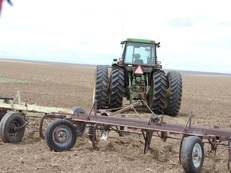
Uniformity is not harmony, just as a straight line will never form a circle. Uniformity is indeed the opposite of harmony, in the sense that one tone can not be harmony, harmony consists of diverging tones who accompany one another in a manner that completes.
From that perspective it’s blatantly inharmonious to shape farmland so contiguous you need up to a 600 horsepower John Deere for towing implements of enough enormity to get a field done by sundown. But this is the farming trend for half a century.
From that perspective it’s blatantly inharmonious to shape farmland so contiguous you need up to a 600 horsepower John Deere for towing implements of enough enormity to get a field done by sundown. But this is the farming trend for half a century.
*****
Agriculturally, the 1960s can be described as the decade of bigger-is-better. Up to then industry had engineered tractors to fit farms; now industry was building tractors as large as they could make them, and farmers were told to get rid of any obstacles in the way of more, More!, contiguity. Economy-of-scale babble drowned out any suggestion that it might not be the wisest thing to adapt the land to the machines.
The obstacles removed for the sake of contiguity were windbreaks and hedgerows.
Farmers got the message in various ways. Universities – the extension service leading – lent support to the bankers’ type of thinking. Governments did their part to speed up the process, in Germany, for example, Flurbereinigung was enforced, a “cleaning up of the ground.” Small fields were consolidated into larger tracts with the agreement of the landowners, some of whom were reimbursed when the land swap put them at a disadvantage, for instance in terms of soil quality; other farmers were simply bought out. It took a few years to map the newly shaped property lines. At the end most hedges had disappeared.
In America food prices were on the rise, which put pressure on the administration of “I’m-not-a-crook” Nixon. Congress also grew concerned, a cheap-food policy being favored because no country had ever experienced a revolution when food expenditures remained below a certain percentage of average income. The upshot was a new farm subsidy program that guarantees producers a fixed price for the big commodities including wheat, corn, soy, cotton, tobacco. “Farm fence-line to fence-line,” was the hue and cry.
What happens when you promise farmers a price no matter how much they produce of a commodity? They go all out after the highest yields. Quantity not quality was and is what they aim for, driven by those subsidies.
What happens during a chronic oversupply? The market slumps.
Who benefits when grain prices plummet? Most of all the livestock industry, and, by extension, the Fast Food industry. Hello McDonald’s! A so-called meal for less than a buck, and you don’t even need to step out of your big sedan.
The obstacles removed for the sake of contiguity were windbreaks and hedgerows.
Farmers got the message in various ways. Universities – the extension service leading – lent support to the bankers’ type of thinking. Governments did their part to speed up the process, in Germany, for example, Flurbereinigung was enforced, a “cleaning up of the ground.” Small fields were consolidated into larger tracts with the agreement of the landowners, some of whom were reimbursed when the land swap put them at a disadvantage, for instance in terms of soil quality; other farmers were simply bought out. It took a few years to map the newly shaped property lines. At the end most hedges had disappeared.
In America food prices were on the rise, which put pressure on the administration of “I’m-not-a-crook” Nixon. Congress also grew concerned, a cheap-food policy being favored because no country had ever experienced a revolution when food expenditures remained below a certain percentage of average income. The upshot was a new farm subsidy program that guarantees producers a fixed price for the big commodities including wheat, corn, soy, cotton, tobacco. “Farm fence-line to fence-line,” was the hue and cry.
What happens when you promise farmers a price no matter how much they produce of a commodity? They go all out after the highest yields. Quantity not quality was and is what they aim for, driven by those subsidies.
What happens during a chronic oversupply? The market slumps.
Who benefits when grain prices plummet? Most of all the livestock industry, and, by extension, the Fast Food industry. Hello McDonald’s! A so-called meal for less than a buck, and you don’t even need to step out of your big sedan.
*****
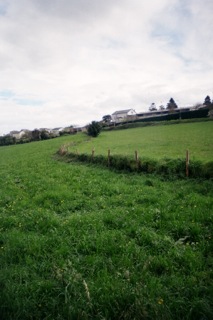
But hedgerows of a thousand years cling to the psyche. That accounts for the sense of warm memory you fathom when seeing a place like Asturias, still a land of hedges in the mountainous North of Spain. Hedgerows size fields so that the mind, the heart can grasp field dimension. Let’s remember that the original definition of Acre is the area a farming man could till in a day with oxen.
Hedgerows direct, the walker must follow them as though the footsteps are stitching a seam of a landscape quilt. Hedges typically follow the lay of land, so a hedge is a contour confirmation. On hilly ground a hedge stalls erosion. Which is one reason why Asturias still has its hedges.
Old Britain was especially hedge worthy. Loose rock in the field was carried to the edge and piled into a long wall, a fence of stones for keeping in the livestock. Next thing you knew, wee birds enjoyed the rocky perch. On days when they’d feasted on berries, berry seed plopped to the ground adjacent to the pasture wall, berry seed well packaged in natural fertilizer. The wind blew flower seeds, tree seeds. What sprouted was the beginning of the hedgerow, a landscape interaction of farming and nature.
In general, biologists investigating a farmscape find more species where nature borders field than in mid-field or in mid-nature. The hedgehog comes to mind, and rabbit, weasel, mole, mouse, and the wildcat of England. The hedgerow bird life was in charge of the acoustics.
In 1980s England science caught up to the fact that hedges had served a purpose larger than as haven for fur and feather. Evidence of this were pests, pests multiplying in the fields like crazy. Entomologists deducted that the old hedgerows had reached out to balance good and bad insects.
Industry put the hedgeless farmers on the chemical treadmill of pesticides, pesticides that poisoned pests and beneficials alike. Not long and you had cascading pest populations. More toxic chemicals were needed. And so on, ever more out of whack...
What about organic farming? It had gained a small following by the 1980s, yet among American scientists hardly a one wanted to envision an agriculture that relied not on chemistry but on biology. Washington and Oregon land grant colleges responded negatively to any request for information about organic farming; it just couldn’t be done, growers were told with many a mean-spirited snicker. Not that this should surprise us, after all, agricultural research had come to depend largely on funding from the chemical industries that had grown out of the military-industrial complex.
But truth will out. In England and a few other countries some researchers bridged farm and ecology.
Turning back the clock to the hedgerow era was too far-fetched a vision in the 1980s, so agro-ecologists like Professor Steve Wraeten of Lincoln University near Christchurch, New Zealand took the novel approach of sorting out just which hedgerow components had been effective in balancing pests and beneficials. After identifying specific pests, and also problem weeds, specific beneficials were studied. What do these beneficials need for their life cycles, what kind of habitat, what food from which specific plants? There were a lot of questions.
One of Wraeten’s students, Alec McErlich, would familiarize organic growers with entomology, first in his native New Zealand, later in the United States. By then entomologists had found terms: “insectaries” the farm habitat for predator bugs and beneficial parasitoids, “beetle banks” the draw for weed-seed-eaters with chomping mandibles.
Hedgerows direct, the walker must follow them as though the footsteps are stitching a seam of a landscape quilt. Hedges typically follow the lay of land, so a hedge is a contour confirmation. On hilly ground a hedge stalls erosion. Which is one reason why Asturias still has its hedges.
Old Britain was especially hedge worthy. Loose rock in the field was carried to the edge and piled into a long wall, a fence of stones for keeping in the livestock. Next thing you knew, wee birds enjoyed the rocky perch. On days when they’d feasted on berries, berry seed plopped to the ground adjacent to the pasture wall, berry seed well packaged in natural fertilizer. The wind blew flower seeds, tree seeds. What sprouted was the beginning of the hedgerow, a landscape interaction of farming and nature.
In general, biologists investigating a farmscape find more species where nature borders field than in mid-field or in mid-nature. The hedgehog comes to mind, and rabbit, weasel, mole, mouse, and the wildcat of England. The hedgerow bird life was in charge of the acoustics.
In 1980s England science caught up to the fact that hedges had served a purpose larger than as haven for fur and feather. Evidence of this were pests, pests multiplying in the fields like crazy. Entomologists deducted that the old hedgerows had reached out to balance good and bad insects.
Industry put the hedgeless farmers on the chemical treadmill of pesticides, pesticides that poisoned pests and beneficials alike. Not long and you had cascading pest populations. More toxic chemicals were needed. And so on, ever more out of whack...
What about organic farming? It had gained a small following by the 1980s, yet among American scientists hardly a one wanted to envision an agriculture that relied not on chemistry but on biology. Washington and Oregon land grant colleges responded negatively to any request for information about organic farming; it just couldn’t be done, growers were told with many a mean-spirited snicker. Not that this should surprise us, after all, agricultural research had come to depend largely on funding from the chemical industries that had grown out of the military-industrial complex.
But truth will out. In England and a few other countries some researchers bridged farm and ecology.
Turning back the clock to the hedgerow era was too far-fetched a vision in the 1980s, so agro-ecologists like Professor Steve Wraeten of Lincoln University near Christchurch, New Zealand took the novel approach of sorting out just which hedgerow components had been effective in balancing pests and beneficials. After identifying specific pests, and also problem weeds, specific beneficials were studied. What do these beneficials need for their life cycles, what kind of habitat, what food from which specific plants? There were a lot of questions.
One of Wraeten’s students, Alec McErlich, would familiarize organic growers with entomology, first in his native New Zealand, later in the United States. By then entomologists had found terms: “insectaries” the farm habitat for predator bugs and beneficial parasitoids, “beetle banks” the draw for weed-seed-eaters with chomping mandibles.
*****
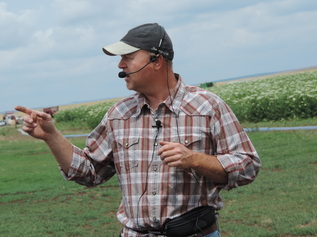
In 2004, Lenwood Farms at Connell in Eastern Washington attracted a lot of visitors on field days. Farmer Brad Bailie stood by his insectary, a four-foot-wide strip of cereal plants and flowers, leaving most of the explanation up to Terry Miller of Washington State University, Pullman.
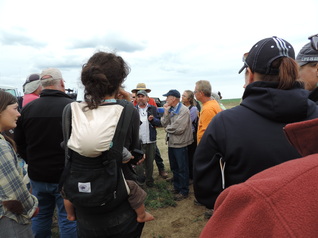
Casually wielding a bug net, Miller told the field day crowd that the insectary project falls under "conservation biological control,” in contrast to “classical biological control."
The “classical” approach was by now an acknowledged success in the Pacific Northwest, and not just for organic growers, Miller elaborated. "When a pest insect comes into a new area where it has no natural enemies, we ask scientists from the pest’s native ecosystem to determine which insects are predators and parasitoids; we then bring some of those pest enemies here, we test them (in labs) and screen them, and release some of them so they form the enemy pool."
The “classical” approach was by now an acknowledged success in the Pacific Northwest, and not just for organic growers, Miller elaborated. "When a pest insect comes into a new area where it has no natural enemies, we ask scientists from the pest’s native ecosystem to determine which insects are predators and parasitoids; we then bring some of those pest enemies here, we test them (in labs) and screen them, and release some of them so they form the enemy pool."
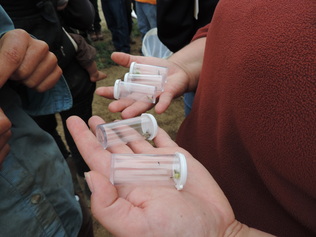
Wheat growers all remember the Russian wheat aphid. "It appeared in Washington about 1989," Miller said. "We worked with scientists in Turkey and Greece to collect enemy species. We released four of those parasitoid species.” They’re wasps, tiny flying critters barely visible to the eye. They find the Russian wheat aphid and bore into it, laying their eggs from which hatch larvae that eat those aphids alive, from the inside out. (So that’s where science fiction horror writers get some of their ideas...)
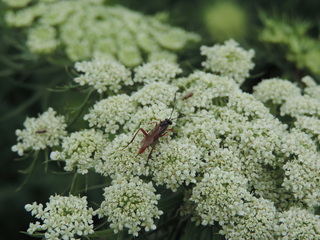
The parasitoids proved themselves: within a few short years the Russian wheat aphid was no longer an issue for Washington wheat growers. Once again an organic method had succeeded, saving conventional farmers the money chemicals would have cost. This scenario would repeat itself after the cereal leaf beetle showed up in Washington at the end of the 1990s. Not long and the pest reduced yields on some fields from 100 bushels an acre to 30 bushels. By 2005 WSU had introduced two Eurasian wasps, one of which parasitizes the pest’s egg, the other its larvae. Before the decade was out the problem was solved to farmers’ satisfaction.
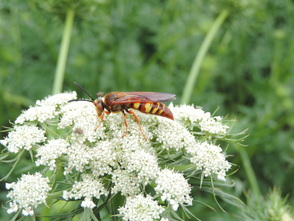
But back to 2004. Miller with his bug net noted that conservation biological control aims to keep beneficial insects happily local, by providing them with sweet incentives – pollen and nectar. Even pests for parasitizing are provided, hence the cereal plants in the flower mix.
The field downwind from the insectary strip grew a super high-value crop, organic potatoes. Spud plants are popular with all kinds of pests, one of the worst of them the green peach aphid; not that it does much direct damage to the potato plant by eating foliage, but, this aphid vectors a virus terribly destructive to the tuber. Net necrosis is the result of plant infection, an unsightly blight inside the potato; since each aphid nibbles on a number of spud plants, every chomp infectious, the little pest can take out whole spud crops.
The parasitoid wasps are introduced to the insectary before the green peach aphid shows up, Miller said. In the meantime wheat aphids of several species are brought to the potato field border: letting the parasitoids feed on the wheat aphids, at first, helps the population growth of the wasps.
The field downwind from the insectary strip grew a super high-value crop, organic potatoes. Spud plants are popular with all kinds of pests, one of the worst of them the green peach aphid; not that it does much direct damage to the potato plant by eating foliage, but, this aphid vectors a virus terribly destructive to the tuber. Net necrosis is the result of plant infection, an unsightly blight inside the potato; since each aphid nibbles on a number of spud plants, every chomp infectious, the little pest can take out whole spud crops.
The parasitoid wasps are introduced to the insectary before the green peach aphid shows up, Miller said. In the meantime wheat aphids of several species are brought to the potato field border: letting the parasitoids feed on the wheat aphids, at first, helps the population growth of the wasps.
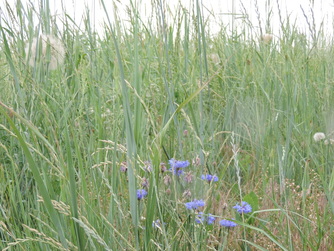
The border of flowering plants included golden margarite, alyssum, dill, buckwheat, fennel, phacelia, centauria. The quarter mile of flowering colors smiling at the summer sky presented a visual relief from the potato expanse beyond. That the insectary is agriculturally functional, so much the better. It certainly piqued interest among organic growers attending the Lenwood Farms field day.
Miller said that it's important for insectary flowering to occur throughout the potato growing season, because nectar and pollen nourish the parasitoid species; in fact, some species including the hover flies actually need pollen for egg development.
The hover flies: if designed for specific wasps who’re brought in for release, the insectary also attracted beneficials who appeared voluntarily. In view of the relative isolation of Lenwood Farms – it’s mostly surrounded by Conservation Reserve Program acres –, Miller was greatly surprised at what all he caught in his bug net: “This project has attracted 29 species of aphid-specific parasitoids and predators."
Miller said that it's important for insectary flowering to occur throughout the potato growing season, because nectar and pollen nourish the parasitoid species; in fact, some species including the hover flies actually need pollen for egg development.
The hover flies: if designed for specific wasps who’re brought in for release, the insectary also attracted beneficials who appeared voluntarily. In view of the relative isolation of Lenwood Farms – it’s mostly surrounded by Conservation Reserve Program acres –, Miller was greatly surprised at what all he caught in his bug net: “This project has attracted 29 species of aphid-specific parasitoids and predators."
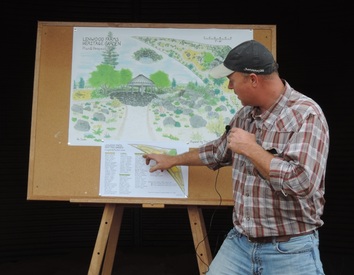
In 2004 the project was in its third year and research was ongoing, particularly in regard to the phenology of insectary plants: "Last year, for instance, we found that mountain mint is highly likely to attract adult cutworm moths (also a pest). That's why mint is not in this year's seed mix," Miller noted.
Sunflower signaled to the wrong insect, too, a moth whose larvae are known as fruit worms.
Financing the insectary project was piecemeal. "Companies like Monsanto are not going to fund this kind of thing,” Miller said. “We get some of our money from the USDA, some from organic companies and organizations, and some funding from the Washington State Commission for Pesticide Registration – it's a new mandate for that commission to also evaluate organic pest control measures."
Sunflower signaled to the wrong insect, too, a moth whose larvae are known as fruit worms.
Financing the insectary project was piecemeal. "Companies like Monsanto are not going to fund this kind of thing,” Miller said. “We get some of our money from the USDA, some from organic companies and organizations, and some funding from the Washington State Commission for Pesticide Registration – it's a new mandate for that commission to also evaluate organic pest control measures."
*****
One of the organic companies involved with insectaries was Small Planet Foods who sent Alec McErlich to contribute to the research that in 2004 spread over three farms. The New Zealander had previous experience Down Under. “I was responsible for building organic (farming) programs for organic vegetable processors,” he tells us in a recent telephone interview.
In Washington, Small Planet Foods was contracting organic potato production when McErlich was hired as research manager at the Sedro-Woolley satellite facility of the company; their headquarters are in Minneapolis; their parent company is General Mills.
McErlich found Terry Miller “a great guy to work with,” ditto Brad Bailie, “a grower who’s becoming an ecologist," as Miller had put it at the field day.
Success with insectaries led to introduction of beetle banks that have the same goal, to encourage populations of beneficials, McErlich says, noting that research of ground beetle habitat also originated in Britain in connection with hedgerow disappearances. Without hedges the beetles were exposed to tillage, a periodic disturbance that depressed their numbers.
“We established three beetle banks at Lenwood Farms, in 2006,” McErlich says. “In total they’re 100 yards long. It took two years to let them mature to how we wanted them.
“A beetle bank is basically a raised mound with grass on top. We planted a mix of orchard grass, fescue and timothy at first; then we went to native grasses that are more drought resistant.”
To ascertain the efficacy of weed-seed-eating ground beetles, research of Lilliputian dimensions is called for: picture a petri dish surrounded by big potato plants; tiny weed seeds are placed in the dish; a wire grid is spanned across the dish to keep the birds out; then a cute little umbrella is attached to keep the weed seeds crisp and dry. In some studies the mandible chomping actually gets filmed with a video camera. “One Midwest feeding study showed that one ground beetle species, called harpalus, ate 90 percent of the pig weed seed. They eat a wide range of seed, including millet, canary grass, and nightshade,” McErlich says.
In Washington, Small Planet Foods was contracting organic potato production when McErlich was hired as research manager at the Sedro-Woolley satellite facility of the company; their headquarters are in Minneapolis; their parent company is General Mills.
McErlich found Terry Miller “a great guy to work with,” ditto Brad Bailie, “a grower who’s becoming an ecologist," as Miller had put it at the field day.
Success with insectaries led to introduction of beetle banks that have the same goal, to encourage populations of beneficials, McErlich says, noting that research of ground beetle habitat also originated in Britain in connection with hedgerow disappearances. Without hedges the beetles were exposed to tillage, a periodic disturbance that depressed their numbers.
“We established three beetle banks at Lenwood Farms, in 2006,” McErlich says. “In total they’re 100 yards long. It took two years to let them mature to how we wanted them.
“A beetle bank is basically a raised mound with grass on top. We planted a mix of orchard grass, fescue and timothy at first; then we went to native grasses that are more drought resistant.”
To ascertain the efficacy of weed-seed-eating ground beetles, research of Lilliputian dimensions is called for: picture a petri dish surrounded by big potato plants; tiny weed seeds are placed in the dish; a wire grid is spanned across the dish to keep the birds out; then a cute little umbrella is attached to keep the weed seeds crisp and dry. In some studies the mandible chomping actually gets filmed with a video camera. “One Midwest feeding study showed that one ground beetle species, called harpalus, ate 90 percent of the pig weed seed. They eat a wide range of seed, including millet, canary grass, and nightshade,” McErlich says.
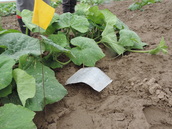
To catch ground beetles for species identification – currently nine are known in Eastern Washington, four of them key species –, pitfall traps are set into the soil, little cones so slick that insects cannot crawl back out.
Unlike the insectary’s specialist parasitoids, the weed-eater ground beetles are “generalists,” that is, they feed on all kinds of things. “They don’t eat potato plants, but they do eat insect eggs. They eat Colorado potato beetle eggs, which is great, but they don’t differentiate, they also eat the eggs of ladybugs and other beneficials,” McErlich remarks.
Organic growers have to accept that biological practices are never 100 percent, he points out. “Weed predation by beetles is no silver bullet. The organic grower can’t go to the pesticide can and wipe out 100 percent of the weeds. But establishing a beetle bank is one of those integrated methods that are very cheap; think about it, all during the cropping season these beetles are out on patrol every day, every night. Since they live in burrows, the beetle bank serves as a nursery to re-populate the field after tillage. The big issue for the farmer is to design the beetle banks and insectaries in such a way that they don’t impede equipment mobility.”
Even after a dozen years of on-farm research, insectary design needs tweaking. “We’re still playing with it,” McErlich puts it. No precise numbers have yet been published, as to how many species an insectary will hold over time, and how far into the field predation and parasitization occurs. But the overall benefit is clear: beneficial populations increase considerably, as do the number of species.
Unlike the insectary’s specialist parasitoids, the weed-eater ground beetles are “generalists,” that is, they feed on all kinds of things. “They don’t eat potato plants, but they do eat insect eggs. They eat Colorado potato beetle eggs, which is great, but they don’t differentiate, they also eat the eggs of ladybugs and other beneficials,” McErlich remarks.
Organic growers have to accept that biological practices are never 100 percent, he points out. “Weed predation by beetles is no silver bullet. The organic grower can’t go to the pesticide can and wipe out 100 percent of the weeds. But establishing a beetle bank is one of those integrated methods that are very cheap; think about it, all during the cropping season these beetles are out on patrol every day, every night. Since they live in burrows, the beetle bank serves as a nursery to re-populate the field after tillage. The big issue for the farmer is to design the beetle banks and insectaries in such a way that they don’t impede equipment mobility.”
Even after a dozen years of on-farm research, insectary design needs tweaking. “We’re still playing with it,” McErlich puts it. No precise numbers have yet been published, as to how many species an insectary will hold over time, and how far into the field predation and parasitization occurs. But the overall benefit is clear: beneficial populations increase considerably, as do the number of species.
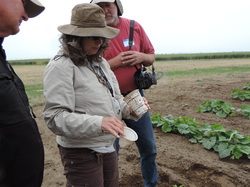
On the other hand, the number of farmers who establish insectaries isn’t exactly growing fast. “Nobody seems to be really pushing the concept,” McErlich sums up, but directs us to speak with Gwendolyn Ellen at the Integrated Plant Protection Center of Oregon State University, Corvallis.
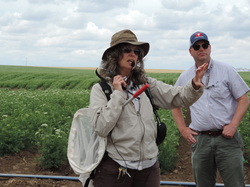
Ellen’s degree is in plant pathology, but her work focus is on the Farm Scaping for Beneficials Program. “To enhance habitat is mandated by the USDA organic rules,” she points out. “It’s been stimulating to see growers diversify their property. Almost every organic grower I know has some configuration of habitat for beneficials.”
More conservation efforts are extended by farmers west of the Cascades, she acknowledges. “Farms are smaller over here, that’s probably why. A lot of farms are around 150 acres, and the fields are smaller, too.”
Also on the west side a lot more beneficial insect species are counted, which is likely due to the more moderate and wetter climate.
Means of conservation vary widely, Ellen says. Managing cover crops such as winter brassica for beneficials is on one end of the spectrum, on the other are actual hedgerows re-established on a farm near Albany.
More conservation efforts are extended by farmers west of the Cascades, she acknowledges. “Farms are smaller over here, that’s probably why. A lot of farms are around 150 acres, and the fields are smaller, too.”
Also on the west side a lot more beneficial insect species are counted, which is likely due to the more moderate and wetter climate.
Means of conservation vary widely, Ellen says. Managing cover crops such as winter brassica for beneficials is on one end of the spectrum, on the other are actual hedgerows re-established on a farm near Albany.
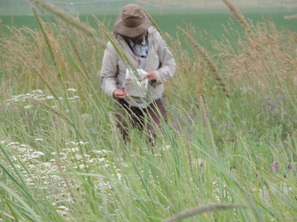
As for precise numbers of insectary-attracted beneficials, a student of hers is getting data ready for publication, Ellen says. “But these numbers won’t be concrete because there is not a linear relationship.” Nature is simply too variable for that.
In her outreach Ellen is in contact with a dozen growers a season; on six farms, five of them organic, she’s directly involved in conservation biological control projects.
She’s positive we’re moving in the right direction: “This is a great time for conservation!”
In her outreach Ellen is in contact with a dozen growers a season; on six farms, five of them organic, she’s directly involved in conservation biological control projects.
She’s positive we’re moving in the right direction: “This is a great time for conservation!”
*****
At Lenwood Farms, one part of the research had placed green peach aphid pests right in the potato field, on potted "sentinel” plants. "We monitor the sentinel plants to find out the distance over which the parasitoids are effective," Terry Miller had explained. "Approximately 50 yards seems to be their range."
Did this aphid transfer make the farmer nervous? "No, I trust that they know what they're doing," Brad Bailie said of Miller and his colleagues. He added that his organic spuds are an early potato, Umatillas that go directly from field to processing, so net necrosis is not as big a threat as in the case of the more commonly raised, later maturing russet Burbank.
Did this aphid transfer make the farmer nervous? "No, I trust that they know what they're doing," Brad Bailie said of Miller and his colleagues. He added that his organic spuds are an early potato, Umatillas that go directly from field to processing, so net necrosis is not as big a threat as in the case of the more commonly raised, later maturing russet Burbank.
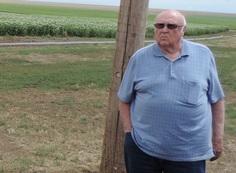
Today Bailie looks back on his early-day insectaries as a worthwhile transition within an overall mind-set change. “Growing up on a conventional farm, organic was not in my thought process,” he relates. “That I became an organic farmer was part circumstance.” When he was in college, the acreage that’s Lenwood today had been enrolled in the Conservation Reserve Program. A first step of reviving the farm ground was to lease some of it, and it so happened that the family rented it to a Basin City grower who needed land that could be certified organic. “When I started farming, in 2003, I decided to keep the farm in organic production, and I’ve not looked back,” Bailie says. "For my Dad, Roger Bailie, it's been a big leap to go organic.”
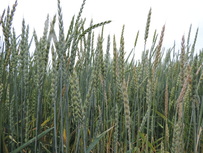
Over the years they expanded their irrigation to 600 organic acres that have produced potatoes, onions, peas, carrots, sweet corn, mint, and also Einkorn, Emmer, Spelt, Camelina and Black Nile Barley as rotation crops. For soil fertility Bailie relies mostly on green manures such as chickling vetch and mustard. Early-season weeding he does mechanically with rotary hoe; in summer he hires farm labor crews who rogue the fields by hand.
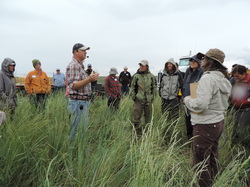
The insectary posed various challenges. Establishing the flower strip was tricky due to the differences in seed size; several passes with the grain drill were necessary. In the crop rotation system the permanence of insectary strips is impractical, so in the fall Bailie would flail-chop his insectary.
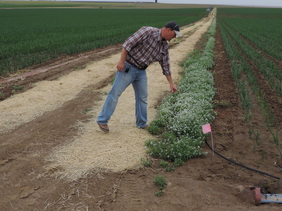
“In an ideal world you’d have little insectary islands in the fields,” he remarks. “But the logistics of that...” Instead he established insectary strips alongside the pivot road that leads to the center of the circle field. “But that’s awkward, when tilling, weeding and harvesting you’re driving across the strips.”
Eventually he settled for permanent insectaries and beetle banks in the “corners.” (When you put a circle field on a quarter section – 160 acres –, the four corners outside the circle add up to approximately 35 acres. Smaller or larger circles of course have the same circle-to-corners ratio.)
Whereas Bailie is not certain if corner insectaries offer adequate parasitization across the whole field, researchers have ascertained that permanent insectaries do indeed lead to resident populations of beneficials. “They’re finding parasitized aphids all the time,” Bailie notes. No longer is it necessary to include cereal grasses in the insectary.
Eventually he settled for permanent insectaries and beetle banks in the “corners.” (When you put a circle field on a quarter section – 160 acres –, the four corners outside the circle add up to approximately 35 acres. Smaller or larger circles of course have the same circle-to-corners ratio.)
Whereas Bailie is not certain if corner insectaries offer adequate parasitization across the whole field, researchers have ascertained that permanent insectaries do indeed lead to resident populations of beneficials. “They’re finding parasitized aphids all the time,” Bailie notes. No longer is it necessary to include cereal grasses in the insectary.
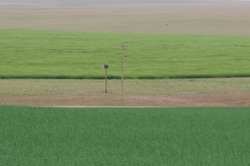
Lately Bailie has noticed how the permanent insectary has influenced bird behavior. A number of years ago he’d put up raptor poles; soon hawks had been enjoying those perches; some of them were, and are, ground-nesting raptors who like it in his tall Farro grain crops. He’s been told they’re Great Northern Harriers. By watching them – “I have lots of videos of hawks” – he determines their nesting site. He sets up a fence around the area, because finding hawks mauled by coyotes is a terrible sight. When he harvests the Farro grains he leaves a fence-guarded island in the field, the young hawks still fledglings. Visitors are always intrigued when they get to view such a protected nest.
“Last year I had four hawk nests,” Bailie says. By now some of the hawks have learned to nest in the permanent insectaries. As have song birds that he used to find nesting in his cover crops. And red wing blackbirds also build nests in the insectary, although that’s not going too well, Bailie says. “The hawks take them out.”
“Last year I had four hawk nests,” Bailie says. By now some of the hawks have learned to nest in the permanent insectaries. As have song birds that he used to find nesting in his cover crops. And red wing blackbirds also build nests in the insectary, although that’s not going too well, Bailie says. “The hawks take them out.”
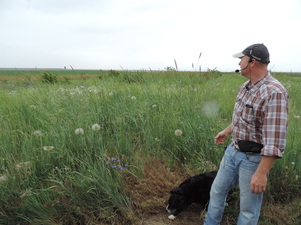
Flowers teeming with beneficials and attracting bird life..., it sounds great, doesn’t it. The catch is that conservation biological control is not cheap even when it’s permanent. “On a per-acre basis the cost is crazy,” Bailie puts it. “You can’t just plant a bunch of flowers and leave them alone. There is lots and lots of (hand) weeding that needs to be done. Some of the flower species spread like weeds themselves – bachelor buttons for example –, they need to be controlled.” Also, as the flower species ratio shifts over time, the balanced-bloom aspect of the insectary needs to be re-established periodically.
Manual labor is expensive. “I figure the insectaries cost me $2000 per acre a year, or even more than that,” Bailie estimates. “I know it’s hard to justify that cost, but insectaries have become part of my farming model. I wouldn’t want to do it any other way.”
Perception of conservation biological control is split, Bailie observes. “The die-hard conventional growers think I’m off my knocker. But the people who come to the field days think the insectaries are great. It’s really a common sense concept – city people can understand what’s behind it, they think it’s really neat.”
Why doesn’t the idea find traction on a larger scale? Why are other countries ahead in research and implementation? Bailie blames farm size in America. “For larger growers it’s too much detail, they don’t think they have the time.”
Such is the curse of contiguity.
For the record: industry claims that huge farms are needed to feed the world are bogus; European studies show that small-farm production potential is greater.
Manual labor is expensive. “I figure the insectaries cost me $2000 per acre a year, or even more than that,” Bailie estimates. “I know it’s hard to justify that cost, but insectaries have become part of my farming model. I wouldn’t want to do it any other way.”
Perception of conservation biological control is split, Bailie observes. “The die-hard conventional growers think I’m off my knocker. But the people who come to the field days think the insectaries are great. It’s really a common sense concept – city people can understand what’s behind it, they think it’s really neat.”
Why doesn’t the idea find traction on a larger scale? Why are other countries ahead in research and implementation? Bailie blames farm size in America. “For larger growers it’s too much detail, they don’t think they have the time.”
Such is the curse of contiguity.
For the record: industry claims that huge farms are needed to feed the world are bogus; European studies show that small-farm production potential is greater.
© 2013 Lentz Spelt Farms


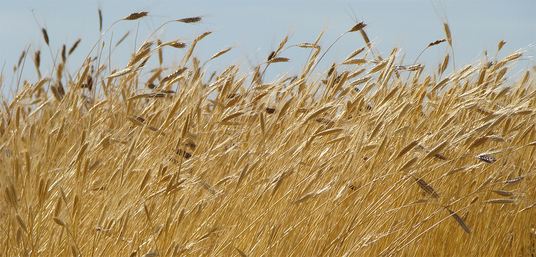
 RSS Feed
RSS Feed